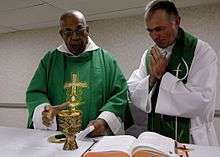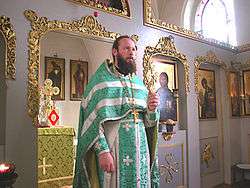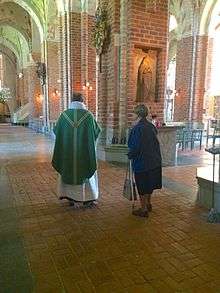Ecclesiastical titles and styles
| Part of a series on |
| Christianity |
|---|
 |
|
|
|
Ecclesiastical addresses are the formal styles of address used for members of the clergy.
Catholic Church
Latin Church clergy

United States
- Pope: Pope (Given Name); His Holiness; Your Holiness; Holy Father.
- Patriarch of an autonomous church: Patriarch (Given Name); His Beatitude; Your Beatitude.
- Cardinal: Cardinal (Full Name).[1][2][3][4][5]; His Eminence; Your Eminence.
- Cardinal who is also an Archbishop: Cardinal (Full Name), Archbishop of (Place); His Eminence; Your Eminence.
- Archbishop: The Most Reverend (Full Name), D.D., Archbishop of (Place); bishops in the U.S. commonly employ a terminal degree as postnominals, e.g., J.C.D or S.T.D., or Ph.D., D.D.; His Excellency; Your Excellency. Titular archbishops almost never have their sees mentioned.[6]
- Bishop: the Most Reverend (Full Name), D.D., Bishop of (Place); bishops in the U.S. commonly employ a terminal degree as postnominals, e.g., J.C.D, S.T.D., or Ph.D., D.D.; His Excellency; Your Excellency. Titular bishops almost never have their sees mentioned.
- Abbot: the Right Reverend (Full Name), O.S.B. (or appropriate order's postnominals); the Right Reverend Abbot; Abbot (Given Name); Abbot (Surname); Dom (Given Name); Father (Given Name); depends on personal and abbey custom.
- Abbess, Prioress, superior of a religious order of women or a province: the Reverend Mother (Full Name), O.S.B. (or appropriate order's postnominals); Mother (Given Name). The title of women religious superiors varies widely, and specific customs of the order should be noted.
- Protonotary Apostolic, Honorary Prelate, Chaplain of His Holiness: the Reverend Monsignor (Full Name); Monsignor (Surname). Postnominal P.A. is often added for Protonotaries Apostolic. Postnominals are rarely used for Honorary Prelates or Chaplains of His Holiness.
- Vicar General: the Very Reverend (Full Name), V.G.; the Reverend (Full Name), V.G.; Father (Surname).
- Judicial Vicar, Ecclesiastical Judge, Episcopal Vicar, Vicar Forane, Dean, Provincial Superior, Rector: the Very Reverend (Full Name); Father (Surname).
- Prior whether superior of or in a monastery or a province or house of a religious order : the Very Reverend (Full Name), O.P. (or appropriate postnominals for the order); Father (Surname).
- Pastor of a Catholic parish, Parochial Vicar, Chaplain, Priest: the Reverend (Full Name); Father (Surname).
- Transitional Deacon (i.e., deacon preparing for priesthood): the Reverend Mr. (Surname); Deacon (Surname).
- Permanent Deacon: the Reverend Deacon (Full Name); Deacon (Full Name); Deacon (Surname); Father (Surname).
- Brother: Brother (Full Name), O.F.M. (or appropriate order's postnominals); Brother (Given Name); in some teaching orders, Brother (Surname) is customary.
- Religious sister or nun: Sister (Full Name), S.C. (or appropriate order's postnominals); Sister (Full Name).
- Candidates for ministry (Seminarian): the Reverend Seminarian (Full Name); Mr. (Full Name); Mr. (Surname).
- Candidates for ministry (Deacon candidate, Lay ecclesial ninister candidate): Mr. (Full Name); Mr. (Surname).
United Kingdom and some other English-speaking countries
The major difference between U.S. practice and that in several other English-speaking countries is the form of address for archbishops and bishops. In Britain and countries whose Roman Catholic usage it directly influenced:
- Archbishop: the Most Reverend (Most Rev.); addressed as Your Grace rather than His Excellency or Your Excellency.
- Bishop: "the Right Reverend" (Rt. Rev.); formally addressed as My Lord rather than Your Excellency. This style is an ancient one, and has been used in the western church for more than a thousand years; it corresponds to, but does not derive from, the Italian Monsignore and the French Monseigneur. However, most bishops prefer to be addressed simply as Bishop (Bp.).
In Ireland, and in other countries whose Roman Catholic usage it influenced, all bishops, not archbishops alone, are titled the Most Reverend (Most Rev.).
Clergy are often referred to with the title Doctor (Dr.), or have D.D. (Doctor of Divinity) placed after their name, where justified by their possession of such degree.
Italy
Similar to, and the source of, most of the U.S. English titles, with some variation:
- Diocesan priest: The Reverend Diocesan (Rev.do.); Don.
- Religious priest: Padre; Father (Fr.).
- Religious sister: The Reverend Sister (Rev. Sr.).
- (Permanent) Deacon: the Reverend Deacon (Rev. Dcn.); may be addressed as Father (Fr.).
The Philippines
In the predominantly Catholic Philippines, ecclesiastical address is adapted from American usage. The titles listed below are only used in the most formal occasions by media or official correspondences, save for the simpler forms of address. Post-nominals that indicate educational attainment or membership in a religious order are usually included.
- The Pope is always given the title Ang Kaniyáng Kabanalan (Filipino for His Holiness). As such, the Pope is styled, Ang Kaniyáng Kabanalan Papa Francisco
- A cardinal is formally styled and addressed as Ang Kaniyáng Kabunyian (literally, His Illustriousness; English: His Eminence). Cardinals are informally addressed as "Cardinal <name>". For example, Cardinal Juan. Unlike in the US or Commonwealth countries, a cardinal's name is always written or printed as "<first name> Cardinal <last name>". For example, Juan Cardinal de la Cruz.
- A bishop is formally titled Ang Mahál na Obispo (His Excellency, the Bishop), and more commonly as Ang Lubháng Kagalanggalang ("The Most Reverend <name>"). In the same way, an archbishop is similarly titled Ang Mahál na Arsobispo (His Excellency, the Archbishop). They are often addressed as "Bishop/Archbishop <name>". For example, Bishop Juan de la Cruz or Archbishop Juan de la Cruz.
- A monsignor is formally styled Reberendo Monsenyor (Reverend Monsignor) although if the monsignor holds extra administrative office, he is styled appropriate to his office. Vicars General, Forane and Episcopal are styled Very Reverend. Monsignori are colloquially addressed as "Monsignor" (abbreviated "Msgr."). As defined, the written form of address for such a priest is Monsignor (first name) (last name) or The Reverend Monsignor (first name) (last name), while the spoken form of address is Monsignor (last name).[7]
- Priests, both diocesan and those belonging to a religious order, are formally titled Reberendo Padre (Reverend Father, abbreviated Rev. Fr.) before their given name and surname. Priests are colloquially addressed Father (abbreviated Fr.) before their name, which may either be a formal name or nickname.
- Deacons are formally titled Reberendo (Reverend). For example, Reverend Juan de la Cruz. In the country, deacons are rarely titled "Deacon <name>" as in the United States. Instead, they are colloquially addressed as Rev as opposed to priests who are addressed as Father.
- Consecrated persons have different styles and addresses.
- Religious sisters are titled as Sister (abbreviated Sr.). Superiors are optionally called Mother (abbreviated Mo.) and are usually addressed formally with the title Reverend Sister/Mother (abbreviated Rev. Sr./Mo.) For example, Rev. Sr. Juana de la Cruz, OP or Rev. Mo. Juana de la Cruz, OSB. Contemplative nuns are formally and colloquially called Sor (short for Soror which is Latin for Sister). Prioresses and Abbesses are formally addressed as Reverend Mother.
- Religious brothers who aren't priests are titled and addressed as Brother (abbreviated Br.). For example, Br. Juan de la Cruz, OFM. And like their female counterparts, contemplative monks are addressed and styled as Fra (short for Frater which is Latin for Brother). Sometimes, monks who are priests are also called Fra.
Eastern Catholic clergy
Although the styles and titles of Eastern Catholic clergy varies from language to language, in the Greek and Arabic-speaking world the following would be acceptable, but is by no means a full list of appropriate titles. It is notable that surnames are never used except in extra-ecclesial matters or to specify a particular person where many share one Christian name or ordination name. Where not noted, Western titles may be supposed. The following are common in Greek Melkite Catholic usage and in Greek Orthodox usage in the United States.
Bishop / Archbishop: In Arabic, a bishop is styled "Sayedna," while in Syriac-tradition churches, he is styled "Mar". If an Eastern Catholic Archbishop or Patriarch is made a Cardinal by the Pope, he may be addressed as "His Eminence" or use the hybrid title "His Beatitude and Eminence".
Priest: In Arabic, "Abouna", and in Greek "Pappas".
Deacon: Identical to a priest in all ways except "Father Deacon" is also heard ("Abouna Shammas" or "Pappas Diakonos").
Subdeacon: Reverend Subdeacon in written address, but the Christian name with or without "Brother" is usually used, except some traditions where "Father Subdeacon" is used. In Arabic, this is confused by the word "Shammas" being used for both the subdeaconate and the deaconate, the distinction being a "Deacon of the Letter" and a "Deacon of the Gospel," respectively. Often a Deacon will be addressed as "Father" and the subdeacon as "Brother" to make the distinction clear.
Reader: Readers are addressed as "Reader" or "Brother" depending on the preference of the addresser.
Seminarians: "Brother" or "Brother Seminarian" is the most common title; the appellation "Father Seminarian" or "Father Student" is not seen outside of rural Greek and Arabic-speaking laity.
Tonsured individuals of no title: Brother.
Eastern Orthodox Churches

Usage varies somewhat throughout the Eastern Orthodox Communion, and not every church uses every clerical rank. Surnames are typically not used for archpastors (rank of bishop or above) or monastics.
- Ecumenical Patriarch of Constantinople: Ecumenical Patriarch John II, His All-Holiness, Your All-Holiness
- Patriarch: Patriarch John II of Terirem, Patriarch John, His Beatitude, Your Beatitude
- Note: Some Patriarchs use the honorific "His/Your Holiness"
- Archbishop
- of an independent Church: The Most Reverend (Rev.) Archbishop John of Terirem, Archbishop John, His Beatitude, Your Beatitude
- of a sub-national Church: The Most Reverend (Rev.) Archbishop John of Terirem, Archbishop John, His Eminence, Your Eminence
- Metropolitan: The Most Reverend (Rev.) Metropolitan John of Terirem, Metropolitan John, His Eminence, Your Eminence
- Titular Metropolitan: The Most Reverend (Rev.) Metropolitan John of Terirem, His Excellency, Your Excellency
- Note: Some Metropolitans use the style "The Very Most Reverend" (V. Most Rev.)
- Note: A Metropolitan who is the head of an independent Church is addressed as "Beatitude" rather than "Excellency"
- Bishop: The Right Reverend (Rt. Rev.) Bishop John of Terirem, Bishop John, His Grace, Your Grace
- Titular/Auxiliary Bishop: same as for Bishops, above
- Other Languages: Sayedna (Arabic), Despota (Greek), Vladika (Russian, Serbian)
- Priest (Presbyter): The Reverend Father (Rev. Fr.) John Smith, Father John
- Protopriest: The Very Reverend (V. Rev.) Protopriest John Smith, Father (Fr.) John
- Archpriest: The Very Reverend (V. Rev.) Archpriest John Smith, Father (Fr.) John
- Archimandrite: The Very Reverend (V. Rev.) Archimandrite John, or The Right Reverend (Rt. Rev.) Archimandrite John, Father John
- Hieromonk (Priest-monk): The Reverend (Rev.) Hieromonk John, Father (Fr.) John
- Other Languages: Abouna (Arabic), Pappas (Greek), Batushka (Russian)
- Priest's Wife: Presbytera Mary (Greek), Khouria Mary (Arabic), Matushka Mary (Russian), Papadiya Mary (Serbian), Panimatushka (Ukrainian)
- Deacon: The Reverend Father (Rev. Fr.) John Smith, Deacon (Dn.) John Smith, Father John, Deacon Father (Dn. Fr.) John, Deacon (Dn.) John
- Protodeacon: The Reverend (Rev.) Protodeacon John Smith, Father (Fr.) John, Deacon Father (Dn. Fr.) John, Deacon (Dn.) John
- Archdeacon: The Reverend (Rev.) Archdeacon John Smith, Father (Fr.) John, Deacon Father (Dn. Fr.) John, Deacon (Dn.) John
- Hierodeacon (Deacon-monk): The Reverend (Rev.) Hierodeacon John, Father (Fr.) John
- Deacon's Wife: Diakonissa Mary (Greek), or the same titles as a priest's wife
- Abbot: The Right Reverend (Rt. Rev.) Abbot John, Abbot John, Father (Fr.) John
- Abbess: The Reverend (Rev.) Mother Superior Mary, The Very Reverend (V. Rev.) Abbess Mary, Reverend Mother Mary, Mother Mary
- Monk: Monk John, Father (Fr.) John
- Rassophore Monk: Rassophore Monk John, Father (Fr.) John
- Stavrophore Monk: Stavrophore Monk John, Father (Fr.) John
- Schemamonk: Schemamonk John, Father (Fr.) John
- Novice: Novice John, John; or Brother (Br.) John
- Note: the title "Brother" is a result of Latin influence; the title is only given to some novices with a special blessing.
- Nun: Nun Mary, Mother Mary
- Rassophore Nun: Rassophore Nun Mary, Sister Mary
- Novice: Sister Mary
Lutheran Churches

- Archbishops/Presiding Bishops: the Most Reverend (Most Rev.); Archbishop (Abp.; Arch.; Archbp.)/Presiding Bishop (P.B.).
- Bishops: Bishop (Bp.); Reverend Bishop (Rev. Bp.); the Right Reverend (Rt. Rev.).
- Pastors: the Reverend (Rev.); Pastor (Pr.).[8]
- Deacons: Deacon (Dcn.).
- Vicars: Vicar (Vic.).
- Seminarians: the Reverend Seminarian (Rev. Sem.).
- Ecclesiastical Doctors, e.g., Ph.D. (Doctor of Philosophy), Dr. Sc. Rel. (Doctor of Religious Sciences/Studies), Dr. Mph. (Doctor of Christian Metaphysics, Dr. Sc. Bs. (Doctor of Biblical Studies), et al.: Reverend Doctor.
Anglican Communion
- Deacons are styled as The Reverend, The Reverend Deacon, or The Reverend Mr/Mrs/Miss.[9]
- Priests are usually styled as The Reverend, The Reverend Father/Mother (even if not a religious) or The Reverend Mr/Mrs/Miss.
- Heads of some women's religious orders are styled as The Reverend Mother (even if not ordained).
- Canons are often styled as The Reverend Canon.
- Deans are usually styled as The Very Reverend.
- Archdeacons are usually styled as The Venerable (The Ven).
- Priors of monasteries may be styled as The Very Reverend.
- Abbots of monasteries may be styled as The Right Reverend.[10]
- Bishops are styled as The Right Reverend or His Lordship.[11]
- Archbishops and primates and (for historical reasons) the Bishop of Meath and Kildare[12] are styled as The Most Reverend.
- The Archbishop of Canterbury is styled as His Grace.
Methodist Churches

- Deacons, Ordained Elders, and Licensed ministers/priesters are addressed as Reverend, unless they hold a doctorate, in which case they are often addressed in formal situations as The Reverend Doctor. The Reverend, however, is used in more formal or in written communication, in addition to His/Her Reverence or Your Reverence. In informal situations Reverend is used.
- Bishops are styled as Bishop or Your Grace.
- Religious brothers and sisters are styled as Br. or Sr.; for example, if their name was John Smith and they belonged to a religious order, they would be addressed as Brother John Smith.
References
- ↑ "Archdiocese of Milwaukee Web Style Guide" (PDF).
- ↑ "Catholic News Service Stylebook on Religion" (PDF).
- ↑ "Religion Stylebook".
- ↑ "University of San Francisco Editorial Style Guide" (PDF).
- ↑ "Associated Press Style Guide" (PDF).
- ↑ http://www.adoremus.org/0809AddressingChurchOfficials.html. Missing or empty
|title=(help) - ↑ Secretary of State 2000: “26. For Supernumerary Apostolic Protonotaries, Prelates of Honour and Chaplains of His Holiness there may be used the title 'Monsignor', preceded, where appropriate, by 'Reverend'”.
- ↑ Peterson, Jason P. (7 October 2013). "Lutheran Reformission: Should pastors be called Father?". Lutheran Reformission. Retrieved 17 December 2017.
- ↑ "How to address the clergy", Crockford's Clerical Directory website.
- ↑ Contact us, UK: Alton Abbey
- ↑ Nathan, George Jean (1927). The American Mercury, Volume 10. Knopf. p. 186. Retrieved 17 December 2017.
When traveling in England they are customarily addressed as "My Lord" or "Your Lordship" and thus put on the same footing as the Bishops of the Established Church of that country, who, when sojourning in America, are properly so addressed. Similarly, a visiting Anglican Archbishop is "Your Grace." He is introduced as "The Most Reverend, His Grace, the Archbishop of York."
- ↑ "The Church of Ireland". www.ireland.anglican.org. Retrieved 12 October 2015.
- Catholic Encyclopedia (1913). Ecclesiastical Addresses.
- Merriam-Webster (1997 HTML edition). Handbook of Style - Clerical and Religious forms of address.
- Greek Orthodox Archdiocese of America. Etiquette and Protocol.
- Orthodox Christian Information Center. Clergy Etiquette.
- Secretary of State, Cardinal (2000) [28 March 1969], Miranda, Salvador, ed., "Instruction on the dress, titles and coat-of-arms of cardinals, bishops and lesser prelates", L'Osservatore Romano, The Vatican, II, p. 4, retrieved 2006-09-01